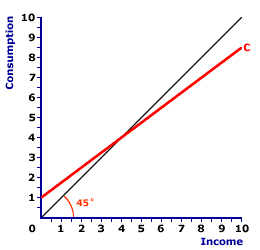
|
|
PLURALITY RULE: A voting rule in which decisions are made based on a plurality of the votes cast. A plurality is defined as the most votes obtained when more than two candidates or options exist, but none receives a majority. If, for example, two of three candidates running for office receive 33 percent of the vote, then the third candidate with 34 percent receives the plurality. Presidential primary elections, which can have up to a dozen candidates, are commonly won with a plurality of the votes. This is one of several voting rules. Others include majority, super majority, and unanimity.
Visit the GLOSS*arama
|
|


|

|
                           CONSUMPTION LINE: A graphical depiction of the relation between household sector consumption and income that forms one of the key building blocks for Keynesian economics. A consumption line is characterized by vertical intercept, which indicates autonomous consumption, and slope, which is the marginal propensity to consume and indicates induced consumption. The aggregate expenditures line used in Keynesian economics is derived by adding or stacking investment, government purchases, and net exports to the consumption line. Saving is indicated as the difference between the consumption line and the 45-degree guide line. The consumption line, also termed propensity-to-consume line or consumption function, shows the relation between consumption expenditures and income for the household sector. The income measure commonly used is national income or disposable income. Occasionally a measure of aggregate production, such as gross domestic product, is used instead.The purpose of the consumption line is to graphically illustrate the basic consumption-income relation for the household sector, which is the foundation of the aggregate expenditures line used in Keynesian economics. Two basic types of consumption are indicated by the consumption line. Autonomous consumption is the vertical intercept, or Y-intercept, of the consumption line. Induced consumption is the slope of the consumption line. Of no small importance, the slope of the consumption line is also the marginal propensity to consume (MPC). | Consumption Line | 
|
A representative consumption line is presented in the exhibit to the right. This red line, labeled C in the exhibit is positively sloped, indicating that greater levels of income generate greater consumption expenditures by the household sector. This positive relation corresponds to the fundamental psychological law of Keynesian economics.For reference, a black 45-degree line is also presented in this exhibit. Because this line has a slope of one, it indicates the relative slope of the consumption line. The two primary characteristics of the consumption line are slope and intercept: - Slope: The slope of the consumption line presented here is positive, but less than one. In fact, the slope of the consumption line is numerically equal to the marginal propensity to consume. In this case the slope is equal to 0.75. The positive slope reflects induced consumption expenditures--more income means more consumption. It also reflects the basic Keynesian psychological law. Click the [Slope] button to illustrate.
- Intercept: The consumption line intersects the vertical axis at a value of $1 trillion. Theoretically, this is a minimum "baseline" level of consumption, the amount of consumption undertaken even if income falls to zero. More to the point, this intersection indicates autonomous consumption--consumption expenditures unrelated to income. Click the [Intercept] button to illustrate.
The other side of consumption-income relation is saving, specifically it is the difference between income and consumption. Saving can be identified by the vertical difference between the consumption line and the 45-degree line. Click the [Saving] button is illustrate this. If the 45-degree line lies above the consumption line, then saving is positive. If the 45-degree line lies below the consumption line, then saving is negative. Lastly, note that the level of income (and production) generated by full employment of resources is NOT indicated in this exhibit. Full employment could correspond with $2 trillion of income or $20 trillion. There is no way of knowing. This is particularly important when the aggregate expenditures line, used to identified equilibrium, is derived based on the consumption line.

Recommended Citation:CONSUMPTION LINE, AmosWEB Encyclonomic WEB*pedia, http://www.AmosWEB.com, AmosWEB LLC, 2000-2024. [Accessed: April 27, 2024].
Check Out These Related Terms... | | | | | | | | | | | | |
Or For A Little Background... | | | | | | | | | |
And For Further Study... | | | | | | | | | | | | | | |
Search Again?
Back to the WEB*pedia
|



|

|
PURPLE SMARPHIN
[What's This?]
Today, you are likely to spend a great deal of time searching the newspaper want ads wanting to buy either a 50-foot blue garden hose or a turbo-powered vacuum cleaner. Be on the lookout for broken fingernail clippers.
Your Complete Scope
This isn't me! What am I?
|

|
|
The New York Stock Exchange was established by a group of investors in New York City in 1817 under a buttonwood tree at the end of a little road named Wall Street.
|

|
|
"Nothing is a waste of time if you use the experience wisely. " -- Auguste Rodin, Sculptor
|

|
X-M
Net Exports
|

|
|
Tell us what you think about AmosWEB. Like what you see? Have suggestions for improvements? Let us know. Click the User Feedback link.
User Feedback
|


|


